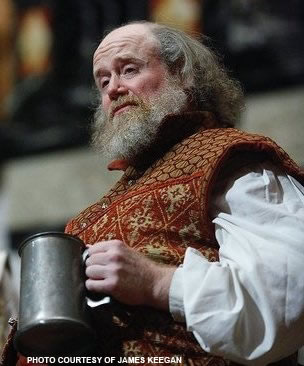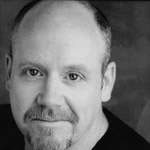An interview with a Falstaff
Love of Life, Love of a Life:
Love for the Fat Knight
By Eric Minton
Having witnessed what he considered some outstanding portrayals of Falstaff before playing the part himself, James Keegan was more influenced by characters from his own life, growing up the son of a man who owned an Irish bar in Queens, New York.
“The people who inhabit the Cheapside tavern are like the guys who came into my dad's bar,” said Keegan, who played Falstaff in productions of The Merry Wives of Windsor and Henry IV, Part 1,in 2009, and Henry IV, Part 2 in 2010 at the American Shakespeare Center's Blackfriars Theatre in Staunton, Va. “There's a love of life but a dangerous edge of dissipation that reside in the neighborhood bar. So the characters who came into my dad's bar have pieces of Falstaff for me, especially the Irishmen because they were very quick-witted.” He even saw Falstaff in his own somewhat-rotund father, who had a knack for offering the clever response to any and every comment or circumstance. “So, there was something about my father's burliness and life that I felt very strongly in Falstaff, more so than other stage Falstaffs.”
This is fitting in that critics see Falstaff as a father figure to Prince Hal, an opinion shared by Keegan who has now played Hal's two fathers—“There's the father of our body and then there are the fathers that we choose,” he said—in two different Blackfriars productions. This may also go some way in explaining how Keegan became so invested in Falstaff that he successfully played the fat knight's three distinct incarnations.
The most famous Falstaff is that of Henry IV, Part 1, where Shakespeare introduced this iconic character, first named John Oldcastle. For Keegan, acting in the production directed by ASC co-founder and Director of Mission Ralph Alan Cohen, everything he needed was in the text: in the rich relationship with Prince Hal (played by Luke Eddy); in the counterpoise with King Henry (who Keegan previously had played at the Blackfriars in a condensed production of the two parts called The Most Lamentable Comedy of Sir John Falstaff); and in the question-and-answer-format soliloquies. In Merry Wives, which was mounted first that season under the direction of ASC co-founder and Artistic Director Jim Warren, Keegan understood that Falstaff had been lifted from the mostly serious, male-dominated world stage of England's government and placed into the slapstick, female-dominated domestic sitcom-setting of Elizabethan suburbia. After the passing of a year, Keegan revised his Falstaff in yet another completely different context with Henry IV, Part 2, a context in which his character is shoved to the side by other portrayals, in which his soliloquies are sermon-like, and in which he had a different actor (Patrick Midgley) playing Hal (Cohen directed this installment). For this, the most difficult of the three Falstaffs, Keegan found his strength in the fat knight as he himself had come to know him.
“The love of Falstaff that I had in Part 1 sustained me in those moments in Part 2 where I felt I wasn't as connected to the audiences as I would have liked to have been,” Keegan said. “I still felt like, ‘I'm Jack, and Jack can talk to anybody, anywhere at any time.'”
The Blackfriars Theatre itself also is a major shaper of performances. In the only replica of the indoor theater used by Shakespeare's own company, The King's Men, the American Shakespeare Center stages plays in the same conditions that those early Jacobean actors worked with, namely, universal lighting, no electronic effects, and an audience all around, including on the stage (the “gallant's stools”) and in the gallery above. It's an atmosphere in which Keegan's Falstaff could not just talk to the audience but engage with the audience and even use the audience. For example, he made the audience in the stalls stand up to present as his army to Prince Hal at Coventry. He could ad lib if he felt a moment merited (Blasphemy! the Shakespeare purists would say—Did it all the time! Will Kemp, the original Falstaff, would say), jumping at opportunities like the night a nun in habit was part of this army of scarecrows. Keegan also took Falstaff into the “in-between space” of theater, not only using as a prop the bar cart rolled onto the stage for the intermission but robbing from the tip jar, something Old Jack would naturally be inclined to do.
ASC is a repertoire theater, with two resident troupes (summer/fall and winter) and a touring company that takes up residence at the Blackfriars in the spring. Many of the actors have remained with the company for more than a half dozen years, and this not only makes for a tight performing outfit, it can even become a psychological subtext for the plays themselves, as Keegan discovered when the actor playing Ford in Merry Wives, John Harrell, was cast as the Lord Chief Justice in Henry IV, Part 2.
Keegan reached the end of his journey as Falstaff with the epilogue that closes Part 2, an epilogue printed in both the Quarto of 1600 and the Folio in two separate parts, which scholars believe indicates that the first epilogue was spoken by Kemp in the public theaters, and the second epilogue was spoken by Shakespeare at a court performance. Keegan spoke a combination of the two, and he emerged on stage as himself wearing a Blackfriars T-shirt and jeans, carrying the Falstaff fat suit he had used the previous year in Merry Wives (he had two different fat suits for the 2009 season “because it made more sense with the shows being in rep and considering how much I perspired in the fat suit,” he said). As the Falstaff fat suit kneeled on the stage, Keegan delivered the epilogue that, in this context, became as much the actor's and audience's parting with this great character as it did a closing apology for the play. Keegan then danced a waltz with his Falstaff costume, took his bows, and exited.
 Keegan has been acting at ASC since 2004. Going into the 2011 summer season, he has played 65 roles in 36 Blackfriars productions, including King Lear, Titus Andronicus, Iago, Dromio of Syracuse, Banquo, Sir Toby Belch, Pompey in Measure for Measure, Stephano in The Tempest, Barabas in The Jew of Malta, and the Ghost, First Player, and Gravedigger in Hamlet. Trained at the Classical Acting Workshop at the Shakespeare Theatre Company in Washington, D.C., Keegan also has acted at the Delaware Shakespeare Festival, and the Pittsburgh Playwrights the Pittsburgh Irish and Classical Theater. With a doctorate in English literature, he is a professor at the University of Delaware, commuting five hours to and from Staunton twice a week to manage both his careers. It's not uncommon to see him hauling a stack of papers to be graded as he leaves the theater after a play (note to his students: remember when writing your papers that it might be graded by Falstaff, Lear, or Titus).
Keegan has been acting at ASC since 2004. Going into the 2011 summer season, he has played 65 roles in 36 Blackfriars productions, including King Lear, Titus Andronicus, Iago, Dromio of Syracuse, Banquo, Sir Toby Belch, Pompey in Measure for Measure, Stephano in The Tempest, Barabas in The Jew of Malta, and the Ghost, First Player, and Gravedigger in Hamlet. Trained at the Classical Acting Workshop at the Shakespeare Theatre Company in Washington, D.C., Keegan also has acted at the Delaware Shakespeare Festival, and the Pittsburgh Playwrights the Pittsburgh Irish and Classical Theater. With a doctorate in English literature, he is a professor at the University of Delaware, commuting five hours to and from Staunton twice a week to manage both his careers. It's not uncommon to see him hauling a stack of papers to be graded as he leaves the theater after a play (note to his students: remember when writing your papers that it might be graded by Falstaff, Lear, or Titus).
In addition to the unusual circumstance of having played Falstaff not just in the three different plays but three different productions over the course of two years, Keegan has a scholar's knowledge of Shakespeare. But it is the Falstaff he came to know intimately on the Blackfriars' stage interacting with 21st century audiences that we discussed in our dialogue in the lobby of the Stonewall Jackson Hotel next door to the Blackfriars, and then over coffee and tea down the street at the Corner Coffee Shop on the morning of March 19, 2011.
September 14, 2011
[For the interview, click here] [For a PDF of this interview, click here]



 Find additional Shakespeareances
Find additional Shakespeareances